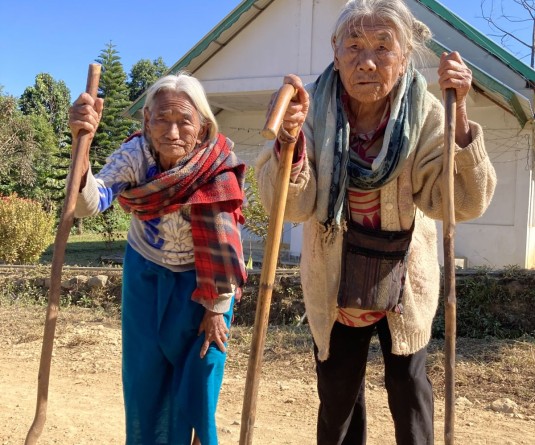
Reimeingam Marchang
New Delhi
In Nagaland, the people predominantly live in the hills depending on agriculture employment. As such large proportion of the household still depends on agriculture particularly in rural areas. In the recent years, self-employed household has increased slightly while regular wage/salary earning household has substantially declined in the state.
The Periodic Labour Force Survey (PLFS) of India classified household type separately for rural and urban areas. Household type is an economic grouping based on the major sources of the household's income or livelihood during last one year preceding the date of survey. Only the net income from economic activities was considered in determining the household’s income.
In rural areas the households were classified into self-employed in agriculture and non-agriculture, casual labour in agriculture and non-agriculture, regular wage/salary earning, and others. Similarly, urban households were classified as self employed, regular wage/ salary earning, causal labour and others. The PLFS (2019-20) estimated that there were 4,23,600 number of households in the state. Out of which 69.1% households were in rural areas and 30.9% of it in urban areas.
In rural areas, the share of self-employed households was considerable at 54.1% during 2019-20 (increased from 50.2% during 2017-18) in the state, against 53.2% during 2019-20 (increased from 52.2% during 2017-18) of the country, which indicates the scarcity of formal or other employment opportunities. In Nagaland, self-employed in agriculture household constituted of 36.9% during 2019-20 which has declined marginally from 37.8% during 2017-18 indicating a gradual decline of dependency on agriculture. Whereas self-employed in non-agriculture formed 17.2% during 2019-20 that has increased from 12.4% during 2017-18.
Increase in availability of non-agricultural employment due to economic development explains the increase of non-agricultural households.
Interestingly, the share of regular wage/salary earning households remains significantly higher in the state (31.7% during 2019-20 declined from 46.8% during 2017-18) than in the country (12.9% and 12.7% during the same period respectively). Contrary to this, the share of casual labour continue to be insignificant in the state (1.9% during 2019-20 and 0.3% during 2017-18), partly due to the absence of casual labour in agriculture, when compared to the national average (24.8% and 25.0% during the same period respectively).
In the state, casual labour in agriculture is not prevailing as majority of them being Scheduled Tribes owns land primarily through inheritance for both agriculture and otherwise purposes. The low prevalence of casual labour households also portrays that Nagaland is lacking far behind in the construction and developmental activities where causal labour are largely engaged in it. Other type of household comprised of 12.3% during 2017-18 and only 2.7% during 2019-20 in the state against 9.1% and 10.1% during the same period respectively of the country.
It is evident that the share of self-employed household has increased primarily at the cost of significant declined of the share as well as absolute number (to 92,723 during 2019-20 from 1,30,478 during 2017-18) of regular wage/salary earning households in rural areas.
In Nagaland in urban areas, the share of self employed household is 30.7% during 2019-20 increased from 28.3% during 2017-18. The self employed households of both rural and urban areas are a heterogeneous group that includes low income, unskilled, low productivity labour, low human capital, high skill, high income professionals etc. In urban areas, the share of regular wage/salary earning households has substantially declined to 37.0% during 2019-20 from 64.8% during 2017-18. Thus, it is evident that the decline of the share of regular wage/salary earning households in rural areas is not because of the transfer or migration of rural households to urban areas. In fact, the number of regular wage/salary earning households has considerably declined to 48,507 during 2019-20 from 76,658 during 2017-18 in urban areas. The decline of regular wage/salary earning households in both rural and urban areas is a serious matter that has a major implication on regular wage employment generation, job security, job satisfaction, livelihood sustainability and other human well-being aspects.
In urban areas, the proportion of casual labour and others household type have increased considerably. Casual labour household has increased to 11.2% during 2019-20 from a mere 0.7% during 2017-18. Similarly, others household has increased to 21.1% from 6.2% during the same period respectively. The category others in rural and urban areas include households whose major source of income is derived from non-participatory earnings from non-labour assets like rent.
In urban areas, during 2017-18, the share of only regular wage/salary earning households of Nagaland was higher than India. However, during 2019-20, the share of only others household type of the state was higher than the country.
Empirically data has shown that in rural areas the share of regular wage/salary earning households of Nagaland (31.7%) was higher than in the country (12.9%) that may be owing to a higher prevalence of educated people (secondary and above educational level for 15+ years) in the state (48.4%) than in the country (31.1%). However, in urban areas, the prevalence of a lower share of regular wage/salary earning households in the state (37.0%) than in the country (43.1%) is a mesmerising scenario when the share of the educated people is considerably larger for the state (64.2%) when compared to the national average (54.4%). It appears either education is not fetching in the labour market or employment opportunities are not available for the educated in the state.
Markedly, the gap between rural and urban areas of the share of regular wage/salary earning households is much narrower in the state by about five percentage point than in the country by about 30% points.




